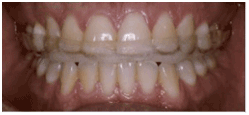WHAT IS TMD?
 The joint that holds the lower jaw below the skull is known as the Temporomandibular Joint, or TMJ. This joint is located in front of your ear on both sides of your head. When it does not work correctly or causes pain, doctors use the term TMD or Temporomandibular Joint Disorder. Problems in the joints or in nearby muscles may cause TMD. Your doctor can give you more details about your diagnosis and treatment options.
The joint that holds the lower jaw below the skull is known as the Temporomandibular Joint, or TMJ. This joint is located in front of your ear on both sides of your head. When it does not work correctly or causes pain, doctors use the term TMD or Temporomandibular Joint Disorder. Problems in the joints or in nearby muscles may cause TMD. Your doctor can give you more details about your diagnosis and treatment options.
SYMPTOMS:
• Jaw pain
• Neck pain
• Headache
• Earache
• Difficult jaw opening: catching, locking, or shifting
• Painful joint noises: clicking, popping, or grating
DIAGNOSIS
Dr Hung will perform a complete evaluation. It may include:
• A review of your medical, dental, and pain history
• A brief social and psychological history
• A physical examination of your head and neck, including muscles, nerves,
jaw joints, and mouth
• Additional testing which may include X-Rays, CT, MRI, laboratory tests,
diagnostic injections, or other tests
CAUSES OF TMD
TMD usually has several symptoms and more than one cause. Research has shown that several things may be acting together, including jaw injuries or joint disease.
Jaw injury: Getting hit in the jaw, or over-stretching from: wide opening during eating, long dental procedures, or inserting breathing tubes for surgery.
Abnormal habits: Clenching, grinding, fingernail biting, and chewing gum can lead to TMD in certain people. These habits can also make it harder to stop the pain.
Occlusion: Research has shown that the way your teeth bite together (occlusion) is rarely the cause of TMD. In a small number of people, it may be part of why the pain is not going away.
Psychological factors: Studies have shown that emotional stress, depression, and anxiety increase pain.
Prescription medications: Some prescription medicines can affect the brain and muscles. This can lead to more pain.
Joint diseases: Several types of arthritis can happen in the TMJ, just like any other joint in the body. Some of these conditions may require teamwork from multiple doctors for your care.
Treatments of TMD
Because there are so many possible causes of TMD, there is no “quick fix” or “cure.” Your TMD symptoms may be temporary and self-limited without serious long-term effects. Your doctor will work with you to help you manage the condition.
Most researchers recommend that you and your doctor should first focus on conservative and reversible therapies. Research has shown that self-management and conservative treatments are the most successful.
The goals of treatment are to decrease pain, to increase jaw function, and to limit the impact of TMD on your daily life. TMD is managed like other joint and muscle problems in the body.
Self-management behaviors: These are some of the most successful ways of helping relieve your pain.
Stress management: Studies have shown that managing stress and anxiety helps relieve TMD symptoms. Your doctor might recommend techniques you can use to help manage stress, or they may also refer you to other practitioners who can give you an additional level of support.
Physical therapy: Physical therapists are trained professionals that help patients rehabilitate from many types of injuries. Your doctor will determine whether physical therapy can help your TMD symptoms.
Medications: Many medicines are available for discomfort. Some of these are traditional pain- relievers, while others work in different ways to treat pain. Your doctor will provide you with a specific treatment plan to fit your needs.
Orthotic: Also known as a stabilization splint, night guard, or bite guard. The design will depend on your condition. It should be used the way your doctor advises. Most orthotics work to keep your teeth apart, to relieve pressure on your jaw joints, and to help your jaw muscles relax.
 Surgery: In cases of severe, constant pain or loss of function, surgery may be needed. Research has shown that for about 5 out of 100 TMD patients, conservative therapy is not enough. These patients may benefit from surgery
Surgery: In cases of severe, constant pain or loss of function, surgery may be needed. Research has shown that for about 5 out of 100 TMD patients, conservative therapy is not enough. These patients may benefit from surgery
